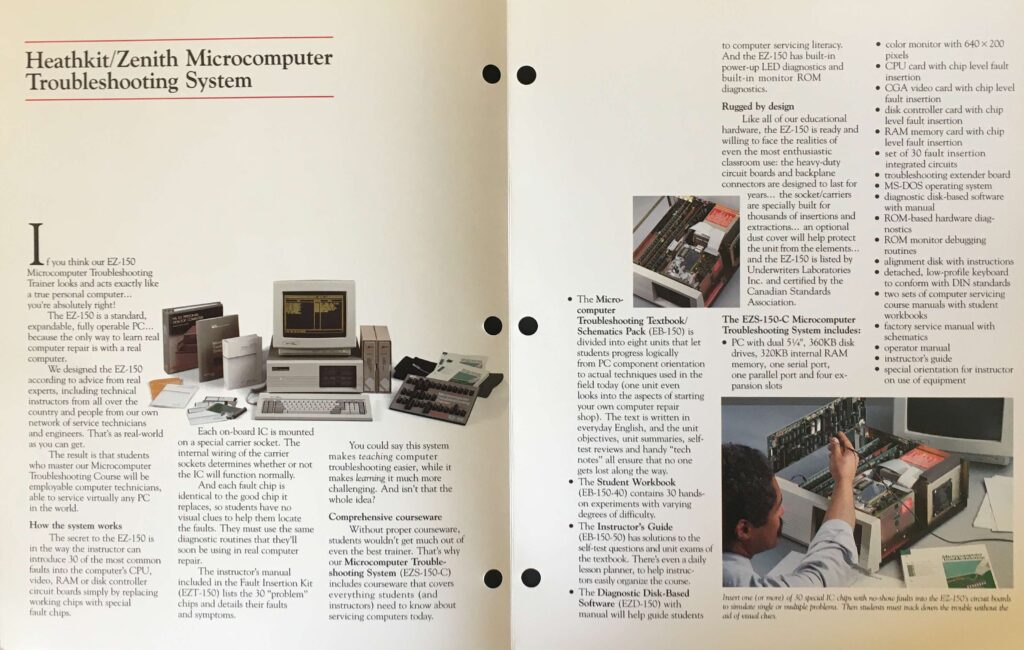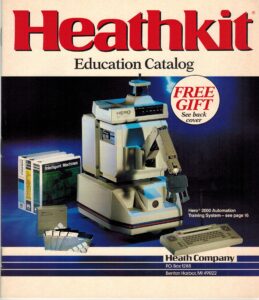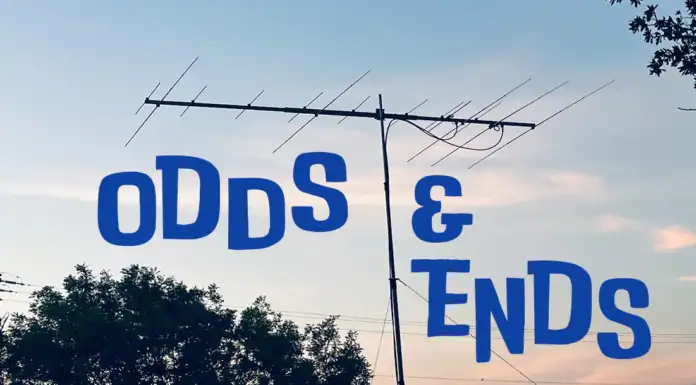I commented recently on the Heathkit products Facebook page about the Morse Code Tapes used in the Amateur Radio General License Home Study Course. I noted that those tapes were generated using one of Heath’s early personal computers. This was one of my projects when I worked at Heath from 1977 to 1989. The follow up comment was “I’d love to hear some of those stories of back in the day.” So, here’s a few.
My Heathkit Credentials
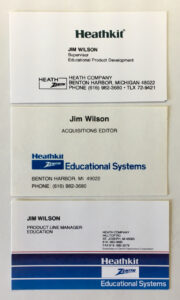 I had the very good fortune to start work in December 1977 as an Educational Product Designer. This meant that I wrote home study courses and pulled together the experiments that supported the coursework. By late 1980 I was promoted to Supervising Editor and then Supervisor of Educational Product Development. In 1984 I was promoted to Acquisitions Editor to spearhead efforts at working with freelance writers. And, from 1986 to 1989 I was Product Line Manager, Education, responsible for all the products in this then $14 million line of publications and training equipment. That included products, promotion, pricing, and distribution (place) in the four Ps of marketing. You can find a few of my business cards from that era nearby.
I had the very good fortune to start work in December 1977 as an Educational Product Designer. This meant that I wrote home study courses and pulled together the experiments that supported the coursework. By late 1980 I was promoted to Supervising Editor and then Supervisor of Educational Product Development. In 1984 I was promoted to Acquisitions Editor to spearhead efforts at working with freelance writers. And, from 1986 to 1989 I was Product Line Manager, Education, responsible for all the products in this then $14 million line of publications and training equipment. That included products, promotion, pricing, and distribution (place) in the four Ps of marketing. You can find a few of my business cards from that era nearby.
My Hiring Experience
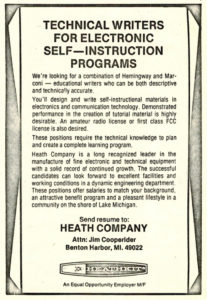 In 1977 working as an electronics instructor I was also writing for 73 Magazine. Perusing QST and/or ham radio magazine I found an advertisement from Heathkit titled “Technical Writers for Electronic Self-Instruction Programs.” It went on to state they were seeking a “combination of Hemingway and Marconi.” The job sounded so perfect that I immediately fired off a cover letter and resume. About two weeks went by and not hearing anything, I sent another. Roughly a month or more later, I received not one but two rejection letters!
In 1977 working as an electronics instructor I was also writing for 73 Magazine. Perusing QST and/or ham radio magazine I found an advertisement from Heathkit titled “Technical Writers for Electronic Self-Instruction Programs.” It went on to state they were seeking a “combination of Hemingway and Marconi.” The job sounded so perfect that I immediately fired off a cover letter and resume. About two weeks went by and not hearing anything, I sent another. Roughly a month or more later, I received not one but two rejection letters!
Yet another few months later I received a phone call asking a few questions and setting up an interview in Benton Harbor, Michigan. Wow, was that exciting. They not only interviewed me but drove me around that beautiful area of Southwest Michigan including the beaches on Lake Michigan. They also told me all about lake effect, where the weather was warmer in the winter and cooler in the summer. When I announced I was moving, my colleagues at the college asked if Heathkit told me about lake effect snow. I scratched my head on that one.
Heathkit Education History
Here’s the snapshot of its start as described by Lou Frenzel in an issue of Electronic Design magazine from 2012:
I went to Heathkit in the early 1970s to start its education and publishing product line. The idea was to extend the concept that building a kit was an educational endeavor and that we could expand on that idea with more formal learning materials to supplement the kits. We built a line of self-instructional courses on electronic fundamentals and a wide range of other topics.
A line of kit trainers accompanied the instructional materials. The first products emerged in 1974 and were instantly successful. We followed up with microprocessor learning packages, which were hot for their time. And, we developed the Hero robot kit that came out in 1982.
Lou was the founder not only of the education business but also Heathkit’s line of early personal computers. He came from McGraw-Hill’s home study business and brought with him several of their executives to get this product line going.
At that time the home study field was big business. The field included McGraw-Hill’s National Radio Institute (NRI) and the Capitol Radio Engineering Institute (CREI). Other firms were the Cleveland Institute of Electronics and the RCA Institute. Their business was fueled in part by the G.I. Bill along with a number of people interested in getting ahead in their careers or moving into a new career field.
Heathkit was actually a supplier of parts kits to NRI and perhaps others. Their kits became one of the motivators for customers to sign up for a course in Television Repair, where their major project was to build a Heathkit color television.
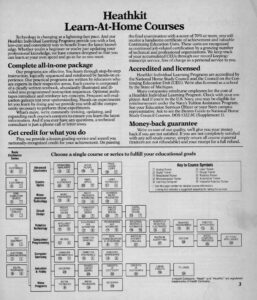 As Lou pointed out above, Heathkit’s concept was rather than compete with the existing schools, some of whom were customers, they would create hobby focused courses that were priced in the range of $100 rather than the $1000+ vocational courses then on the market. They also provided low cost breadboard systems with signal generators built in as well as their existing test equipment from VTVMs to oscilloscopes.
As Lou pointed out above, Heathkit’s concept was rather than compete with the existing schools, some of whom were customers, they would create hobby focused courses that were priced in the range of $100 rather than the $1000+ vocational courses then on the market. They also provided low cost breadboard systems with signal generators built in as well as their existing test equipment from VTVMs to oscilloscopes.
Heathkit could also leverage their outstanding documentation expertise – writers, editors, illustrators, typesetting, and printing. Add a few parts to the course for hands-on experiments, which also fit their expertise, and you were all set.
Early courses were in DC, AC, Semiconductors, Electronic Circuits, test equipment, and digital techniques. I wrote their Electronic Communications course. See the nearby page listing their offerings taken from a catalog around 1989. Click on the image for full size.
Heathkit Education Staffing Strategy
The Education Department hired instructors who could write, often retired military instructors. When I arrived in late 1977, they had about six or eight writers on staff. We worked with the editors, illustrators, typesetters, and proofreaders that also worked on the kit manuals. They really knew their business.
Of particular value were the illustrators. Their work on education courses must have been fun compared to their detailed drawings for the kits. Heath did not use photos but only illustrations because they could be better drawn to depict exactly what was needed by the builder — minus any clutter or even perspective that didn’t facilitate accurate assembly.
As the coursework expanded to topics outside electronics, Heathkit found that they needed to hire freelancers to bring expertise for a particular topic. One early example that proved this point was hiring a full time writer for a proposed astronomy course. They hired the guy, moved him to St. Joseph Michigan where it is cloudy from October to May, and found that he not only didn’t like the neighborhood but that there was not really another course for him to take on after the first one. He left before the first course could be completed.
My Projects and Writing Challenges
My first projects at Heathkit were mostly around editing existing home study courses and moving them into textbook format as well as following them through the production process. I also was charged with taking some existing books from Howard W. Sams Publishing and moving them into home study courses.
Over roughly that first year I established a reputation for hard work and getting things done. That was good because we all discovered that getting words down on paper, which I had done to a fare-thee-well in the past, didn’t mean you could write to Heathkit standards or even to generally sound communication practices.
Fortunately, my boss Doug Bonham, started coaching me including going over every sentence and paragraph. We also had two exceptional editors that provided plenty of feedback.
My major discovery from working with my boss was that you needed to carefully assemble every sentence word by word. Then you needed to clearly link that sentence to the next one followed by paragraphs.
My first thought was literally that I couldn’t be worried about sentences, I had chapters and full home study courses to write. He convinced me otherwise. He helped me understand the full meaning of what it takes to become a “wordsmith.”
Morse Code Audio Tapes
In my time as a writer from 1977 to 1980, I managed to produce a number of home study courses. Perhaps a highlight was the Amateur Radio General Class License Home Study Course. This one taught in detail all the information covered in the license exam. That included developing Morse Code tapes that were generated with one of Heathkit’s first personal computers.
 Those tapes used the now famous Koch Method, where the characters are sent at say 15 words per minute but the spacing increased for an overall speed of 5 words per minute. This meant that you learned the correct sound from the start and only worked on lowering the spacing over time to build your receiving speed.
Those tapes used the now famous Koch Method, where the characters are sent at say 15 words per minute but the spacing increased for an overall speed of 5 words per minute. This meant that you learned the correct sound from the start and only worked on lowering the spacing over time to build your receiving speed.
We had a Heath programmer set up an early H8 personal computer to generate the characters. Then I sat down with a recording engineer to record the voice and he literally cut reel-to-reel audio tape to splice the Morse characters into the voice sequences to product the master for the cassette tapes.
The back story is that Wayne Green, N2NSD, at 73 Magazine published one of the first Morse Code tapes using the Koch method. Since I knew him from writing for his magazine, I gave him a call to ask how he did it. He said, “let me see now, you’re a competitor and you’re asking me how to go into competition with me.” I said yes and he told me he used a keyer and a metronome to time the characters. I’m not sure that’s what he really did. But it sounded typical for a driven entrepreneur.
Education Product Line Management
After stints as supervisor of educational product development and acquisitions editor as well as one year managing Heath/Zenith’s personal computer publications efforts, I returned as Education Product Line Manager. As those familiar with this role can attest, it’s tough to get everything done across so many activities and do so primarily with moral suasion — limited or no authority coupled with unlimited responsibility.
Our big challenge was competing for manufacturing resources for our relatively tiny group of products against a billion dollar line of computers. You’re always going to lose that competition, which meant that we needed to go to the Far East for manufacturing. It made for interesting trips and working with some incredible people.
As Lou Frenzel mentioned, robotics became a big part of our product line. By my time as product line manager, the second generation Hero 2000 robot was introduced. This included an articulated robotic arm on top of the rolling robot.
One of the challenges we found was that Heathkit was a superb electronics and computer company. But they had a total of two mechanical engineers on staff. This product was way outside their expertise and experience. Even so, it was a spectacular product albeit with a few mechanical weaknesses.
One of my highlights during this job was introducing a computer repair course. It used the Heathkit computers along with some ingenious work by our engineers to introduce problems that could then be used for troubleshooting exercises.
As you might imagine, this course was not suited nor priced for the home market. It was specifically targeted to technical schools and was sold through sales representatives who called on tech schools with a complete line of products to fulfill their needs. Based on my own experience teaching and running vocational education programs, I really enjoyed serving this market.
That was one aspect of the distribution side of this job. We also had home study customers who were literally using our products on their kitchen tables at night. They purchased their products via mail order catalog or at Heath retail stores. This made for a very broad range of opportunities and challenges.
What a Wonderful Experience
That’s a brief summary of my time at Heathkit along with a few stories suitable for general audiences. I greatly enjoyed my time there, loved Southwest Michigan, as well as personally and professionally grew a ton. That included earning bachelor and masters degrees thanks to Heathkit’s tuition reimbursement program. Plus, I met and married the love of my life.
The following journey to Texas also has had its rewards, including not shoveling snow, and working for the other great organization in my career, the Boy Scouts of America. Perhaps that’s a story for another day.

